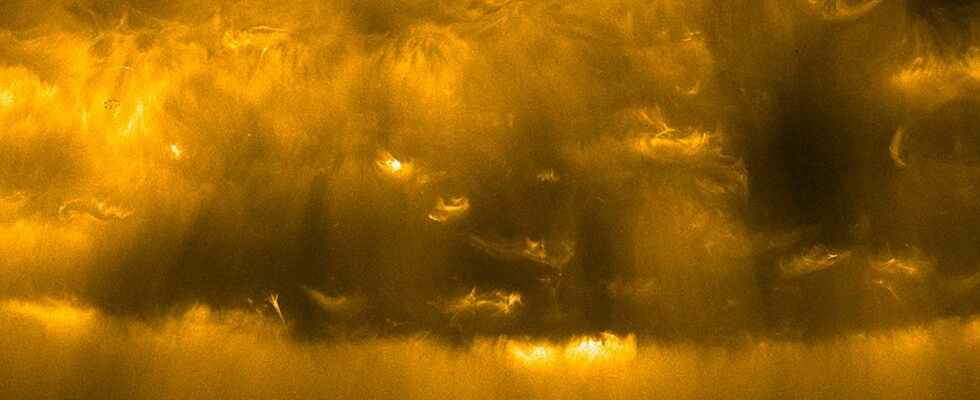” The pictures are truly breathtaking says David Berghmans, of the Royal Observatory of Belgium, and principal investigator of the Extreme Ultraviolet Imager which takes high resolution of the solar corona. It is in these terms that the Press release of the European Space Agency (ESA) which presents the first results and data of the passage of the Solar Orbiter probe as close as possible to the Sun. Launched in February 2020the probe performed its first perihelion closer on March 26 to just 0.32 AUor approximately 48 million kilometres.
The pictures are truly breathtaking
David Berghmans’ enthusiasm is understandable. During this passage, the 10 instruments on board recorded unprecedented data and the probe acquired breathtaking views of the solar poles as well as a curious “hedgehog” which extends over 25,000 kilometers and presents a multitude of peaks of hot gases and cold in all directions. After the solar campfiresthe Extreme Ultraviolet Imager team came up with a rather surprising word for a solar phenomenon.
The whole challenge for the scientists on the mission will be to cross-reference the data from the remote sensing instruments (remote observation of the activity of the Sun) and the data from the instruments in situ which analyze the environment of the probe where the fluxes of solar particles arrive. In other words, make the connection between what the probe sees and what the probe “feels”.
The Solar Orbiter mission is not yet finished that already we can say that the scientific objectives will be fulfilled. When the probe is launched in 2020, the goal is to better understand thestar we live with, providing unprecedented insight into how it works and how it affects the space environment around Earth and beyond. Its main objective is to better understand the link between the Sun and theheliospherethis zone in the form of an elongated bubble formed by the solar winds, plasma of charged particles continuously emitted by the Sun. These scientific successes are also technological successes. Because approaching so close to the Sun and looking at it directly was akin to an unprecedented technological gamble when designing the probe.
And there too, the bet is won. By venturing only about 48 million kilometers from the Sun, Solar Orbiter was exposed to temperatures of around 500 to 600°C! Well protected by the probe’s heat shield, all the instruments were able to operate normally. This close perihelion of March 26 is a real success for the Solar Orbiter mission, confirms Desi Raulin, Solar Orbiter project manager at Cnes: “ the French scientists are very happy with the result because they were able to collect a lot of data. All instruments work perfectly. It is a real relief that the space probe has acquired so much data via its instruments and with such a high quality of resolution. “.
Lay the foundation for a reliable and accurate system capable of predicting solar phenomena
Solar Orbiter also aims to contribute to the creation of a real meteorology spatial. And here too the bet is won. By combining data from all of the probe’s instruments, scientists are able to understand how solar activity works from the Sun’s surface to Solar Orbiter and beyond. This knowledge is exactly what will pave the way for a future system to predict space weather conditions on Earth in real time. Approaching perihelion, Solar Orbiter even got a glimpse of how such a system works!
On March 10, an ejection of mass coronal passed through the probe. Its onboard magnetometer predicted that it would strike Earth several hours later. Breaking the news on social media kept sky watchers ready for the aurora sightings, which occurred about 18 hours later than expected.
This experiment gave Solar Orbiter insight into real-time prediction of space weather on Earth. Such an endeavor is becoming increasingly important because of the threat that space weather poses to technology, to human activity in orbit bass and future lunar and Martian exploration missions.
Solar Orbiter confirms Vigil’s interest. This European Space Agency mission will be launched on the 2025 horizon to Lagrange point number 5. From this location, Vigil will be able to study all extreme and unpredictable solar events even before they occur. perceptible from the Earth, such as solar flares and “coronal mass ejections”, and before they hit it.
This perihelion was therefore a huge success and generated a large amount of data. And as the ESA points out, this is just a taste of what’s to come! In October, the probe will come even closer to the Sun, just 0.29 times the Earth-Sun distance.
Right now, receive the Mag Futura for free by subscribing to our subscriptions!
Did you know that you can access Futura without ads via our subscriptions?
At the moment, you can discover this advantage with our special offer: subscribe to the subscription “I participate in the life of Futura” (for a minimum of 3 months) and receive the Mag Futura at home* (worth €19)!
*Mag Futura is sent after the third month of registration.
Interested in what you just read?

